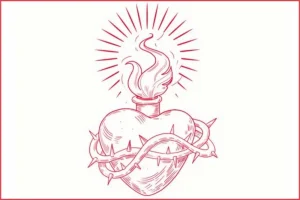Introduction to psychological wounds
Overcoming Psychological wounds, definition and causes. In two articles we will enter the world of psychological wounds, with the aim of getting to know them better and helping to overcome them. We hope that these ideas will be useful at different levels. Knowing oneself better favors a more serene life and being attentive to others. Reading these lines can make someone discover the root of some difficulties that perhaps have been affecting them and making them suffer for years. This knowledge and better understanding is the starting point to alleviate the pain.
In the second part, we will face more closely how to accompany the wounded person and how to help him/her to recover with a new attitude.
Table of contents: overcoming wounds
- 1. Definition of wounds
- 2. Some types of wounds and resilience
- 3. Traces left by free actions and decisions
Read the article in Spanish and see the bibliography
Physicians have been dealing with wounds on the body for thousands of years. A papyrus from 1650 BC carefully explains how to treat them, with herbs, incisions and ointments, probably with some benefit to the poor unfortunates.
Today, many serious injuries can be cured. Psychological and spiritual wounds, the disease of the mind and the disease of love were also known in ancient times. Progress has been made in these areas, but there is still a long way to go.
Both medicine and spiritual accompaniment have to consider the possible injuries of the psycho-spiritual dimension. And this requires study. Gregory the Great, in the 6th century, warned that the wounds of the spirit were deeper and more difficult to discover than those of the body, and that it was necessary to study in order to deal with them successfully.
In recent years, more importance has been given to the concept of psychological wound. There is no unanimity in the definition, but it is clear that they are not reduced to harm from physical abuse. They can be either a single painful or distressing experience, or an acute trauma; or they can also affect the person, especially children, for a long period of time: we speak then of a life lived in trauma.
Numerous mental health problems are related to injuries
About 50% of adult depressions have roots in childhood traumas. In many other symptoms of psychic discomfort or in ways of being that cause suffering there is an old emotional injury. Even brain morphology can be altered by early psychological wounds.
We will enter into this world, because of its importance for the spiritual life. We start from the unity of the human being. A crack in any dimension, physical, psychic or spiritual, endangers the structure of the personality. We will also keep in mind the instrumental power of God’s grace, which heals in depth.
In a Christian vision, wounds condition a person’s performance, but do not determine it completely.
We will see how the adult carries over his or her childhood wounds. We all still have a child inside us. In physical health, if the defense mechanisms have deteriorated, a mild illness or infection produces greater damage. If in childhood there is a heart defect or a major blow, health and way of life are altered. The same happens in psychology.
Creativity in people with psychological wounds
There are ways of feeling, behaviors or ways of thinking and judging the world, ways of understanding oneself and relating to others, which are the echo of old injuries. Those who, as children, suffered some kind of mistreatment or loss, will be more hurt by any appearance of abandonment or contempt, even if it is small: for example, a negative response, the death of a pet, or watching a drama at the movies. This can bring a greater sensitivity and it is possible to rewrite or edit with new lights what happened, as we will say.
The aftermath is more harmful when love has been lacking. Many unwanted or addictive behaviors are incited by wounds and an unsatisfied need for love. Attempts are made to compensate for the emptiness with excesses and addictions. Lack of self-esteem is covered up with perfectionism and activism, to prove worth that others do not appreciate. Perfectionism often manifests the desire to fix one’s own flaws, the longing to be approved, loved, taken into account.
Psychological wounds and new bonds
The reactions of a wounded person are also marked. They are easily closed; it is difficult for them to create bonds or friendships. Sometimes they are violent and unpredictable, like a hurt little animal that suddenly turns around and confronts us in a threatening way. We know how dangerous it is to approach any beast in such conditions.
It can happen with wounds as in that Mexican song: Acá entre nos siempre te voy a recordar / y hoy que a mi lado ya no estás / no queda más que confesar / que ya no puedo soportar / que estoy odiando sin odiar / porque respiro por la herida. (Here between us I will always remember you / and today that you are no longer by my side / there is nothing left to do but confess / that I can no longer bear / that I am hating without hating / because I breathe through the wound).
We hope that these lines serve to take charge of the stories of personal suffering, to look with empathy into the world of the other. And to those who have suffered a wound, to recognize if it requires someone to examine it, to clean it, to disinfect it, before it gets deeper.
1. Defining psychological wounds
Analogous to what happens in the body, a psychological wound is a discontinuity. A cut in the skin leaves the tissues more or less separated and the deep structures, such as muscles, nerves or blood vessels, defenseless… A psychological wound breaks the continuity of mental processes. Affections, behaviors, cognition and relationships run without complete order and coherence.
Psychological wounds in gestation and infancy
These ruptures can occur in childhood or even during the gestation period. Some adverse circumstances that the mother may suffer can translate into an increase of chemical substances that pass from the mother to the child, break the natural shield of the placental barrier and leave their mark on the neurological system of the child that is still forming.
The mind is altered, depending on the time of existence at which the injuries occur and the intensity of the trauma. Children under two years of age do not have fundamental tools for consciousness, such as language. They have little or no awareness of what is really happening and cannot link the injury to the causal situation. Throughout childhood, especially before they reach autonomy, they are more susceptible to traumatic impairment, because of the inability to name harmful events, make sense of them or distance themselves from them.
When the basic needs for acceptance, identity, autonomy and self-esteem are not met, the discontinuity in mental processes is more evident. Emotional pain increases in intensity, particularly in the face of rejection, which is most frequent. This pain is not easy to control with reason or medication alone. It often translates into other symptoms, such as organic or visceral pain; and is accompanied by negative emotions such as anger and aggressive impulses against oneself or others.
Rupture of personality pillars
In a wounded child, the pillars of personality are altered. Self-esteem decreases, which is equivalent to having a low immune system; and the sense of belonging, of being valued in oneself, is weakened. When adolescence arrives, the development of two fundamental binomials may be lacking: identity-intimacy, fidelity-love.
In addition to producing negative emotions and hypersensitivity, trauma is capable of causing the opposite: a kind of emotional anesthesia. These are two extremes that depend on the frequency and intensity with which traumatic events are experienced. In the person with chronic emotional suffering -who lives in trauma- the alarm systems may be overloaded or hypersensitive and “jump” at the slightest stimuli. But sometimes it happens that, after so much activation, they melt down, become exhausted or “turn off”.
Defects of loving and being loved
Hence, a fundamental objective for wounded people is to experience the normal pleasures of life. They need to be helped to feel that their body belongs to them again and to know how to take care of it, and especially to appreciate the beauty of themselves and their surroundings. In this way it is easier for them to perceive love again.
To love and to be loved is a need that is not satisfied or is weakened in numerous types of wounds. The consequences drag on for life. Stefan Zweig’s “Letter from an Unknown Woman” is a good example of this. An anonymous young woman records her tragic story in a posthumous letter to her platonic love. Until the last second, until the last line, this young woman has moved in search of affection and recognition. But she presents herself as somehow “anesthetized”. Already as a child she is incapable of realizing her wrongdoings, incapable of facing reality with determination. She fails to make her emotions known, and continually pursues an illusory and distant love.
Of her childhood, Zweig relates only that she was fatherless and that her mother was unloving. A detail, apparently unimportant and in parentheses, sheds some light. It is an ordinary day, when her mother reveals to her in passing that she will remarry a relative who is also a widower. And this is how the beginning of that encounter is laconically described: “she kissed me (something she never did) affectionately on both cheeks”. The deficit of affection, neither discovered nor cured, will accompany her throughout her life.
2. Some types of psychological wounds and resilience
Injuries can occur in children and adults. The consequences are more severe in childhood, as we said, because mental processes are weaker and unprotected. Emotional regulation is lower, because the control mechanisms of the prefrontal cortex that restrain the cerebral amygdala, the core of emotional alarms in our brain, are not fully developed. The adult has more capacity to rework or reframing experiences and adapt.
A related condition, which encompasses many types of injuries, is trauma. It consists of the continuous repetition of the painful event. This event can be observed in others or experienced in first person: accidents, earthquakes, unjust or violent acts, etc. The subjective personal experience affects the most intimate of mental processes.
There are three aspects that define trauma
- Exaggerated response to any stimulus reminiscent of the traumatic event.
- Unwanted and uncontrollable (intrusive) thoughts that repeat the threat.
- Pathological fear or phobia of any memory of the event.
There are 5 main causes of trauma in childhood
- Emotional abuse
- Physical abuse
- Sexual abuse
- Emotional neglect
- Physical neglect
In reality, injuries are often multifactorial. That is, someone who is subjected to one of these causes usually suffers from two or more others. For example, someone who has been physically or sexually abused usually endures other forms of abuse and neglect of care. Abused children are more vulnerable to other types of violence and bullying.
Injured children often spend most of their days in a hostile environment. The younger they are, the less able they are to remove themselves from that environment. When they enter school, they may take refuge there and, as they grow older, manage to return home later.
Injuries affect behavior, choices and the emotional system. They are considered to be lodged in the unconscious. The psyche does not forget emotions or sensations, but stores them. In some cases, emotions are “buried alive”, in Anna Terruwe’s expression. Wounds can be caused by traumatic events or by other people, voluntarily or involuntarily.
Emotions and psychological wounds
From a psychological point of view, childhood wounds are encompassed in 5 experiences, which give rise to a more marked emotion:
- Rejection → Fear
- Abandonment → Anxiety
- Humiliation → Shame
- Betrayal → Anger
- Injustice → Indifference
Rejection can influence even before birth. Children need to be accepted and confirmed in their worth (this is what Anna Terruwe and Carl Baars called affirmation). Early abandonment, between birth and three years of age, is particularly harmful, as confirmed by John Bowlby and Mary Ainsworth’s Attachment theory. The fear of losing an attachment is prolonged in the future, causing harmful dependencies with other people and suffering greatly any loss.
Children, when they suffer humiliation due to physical, moral or sexual abuse, develop negative thoughts: they convince themselves that they are not worthy of anything, that they are not worth anything. They grow up shy and ashamed. If they are betrayed, they lose the ability to trust and give free rein to their desire to control everything and to perfectionism and anger, or to disappointment and sadness. This is what happens in some cases of parental separation or divorce.
Those who have suffered injustice may create a thought of the type: I must be perfect to be loved. Sometimes, it is fostered by overly demanding parents, who seek to enlarge their own ego in their child: to be the best, with the best grades, lots of extracurricular activities, etc.
Cases of wounded children are abundant, as Pope Francis wrote: ” Many people leave childhood without ever having felt unconditional love. This affects their ability to be trusting and open with others ” (Amoris Laetitia, 240).
Inappropriate behaviors and psychological wounds
Later, in the adolescence of traumatized young people, inappropriate and high-risk behaviors emerge more often:
- Drug or alcohol abuse.
- Promiscuity.
- School dropouts.
- Reckless behaviors prone to borderline and dangerousness.
- Bullying.
- Violence.
- Delinquency.
Many serious assaults in the family setting are caused by injured people, especially when they feel rejected. The vast majority of cases of gun violence in U.S. schools have been caused by rejected youth.
When there is not just one harmful circumstance, but the whole life is traumatic, we speak of complex trauma. The first of these complex traumas is the absence of an attachment figure in childhood, in particular the mother, who allows a serene exploration of the environment and is the main factor regulating emotions. This is followed by the causes we have already mentioned.
It is not easy to recognize the existence of a complex trauma, because it is necessary to go beyond appearances, to have time and to take a real interest in the person. One of the possible confusions can be with Attention Deficit and Hyperactivity Disorder, widely diagnosed in schools. They are distracted and hyperactive children, who sometimes can cover up a traumatic situation that grips them, and therefore their diagnosis is different. A good professional practice of psychologists and teachers will favor the investigation of possible traumas, past or present, before symptoms that affect executive functions.
Along with these classic injuries, there are what we could call the wounds of everyday life. They are those frequent painful sensations – sometimes disproportionately painful, like a thorn in a finger – that occur more or less frequently in children and adults. They are the everyday scrapes, which our Self increases and sometimes do not even exist.
Every wound hurts because it affects basic needs
- Rejection → Belonging or being accepted.
- Feeling of loneliness → Socializing with empathy
- Loss → Security, identity, meaning
- Guilt → Healthy relationships
- Ruminating on ideas → Conciliatory reflection
- Failure → Being valued
- Low self-esteem → Being loved
We will see later that it is necessary to pay attention to them and have a good first aid kit. It jumps out that any of them hurts more when it is due to or caused by people closest or dearest to us. But even to feel rejection by someone we see for the first time and will never see again, makes us suffer. And we suffer more if we have similar experiences in our emotional memory. Wounds are related and facilitate other types of injuries: they are self-propagating and contagious.
Studying wounds requires effort and the certainty that they are worth discovering and healing. There are those who seem capable of overcoming any adversity: a grandfather who has suffered hardship, famine and perhaps war; a sick person with multiple chemotherapy treatments; that widowed mother with small children… What contributes to that extraordinary strength? If analyzed in depth, that strength lies in having become aware of their pain and the meaning they give to their lives, the desire to love, to give of themselves, and the support of those around them.
These are the elements of our second theme: resilience. From the Latin resiliens, it refers to the ability of living beings to cope successfully with adverse situations or harmful agents. In psychology, it designates the ability to bounce back or start over from wounds, to get back on one’s feet after a blow.
Levels of resilience in psychological wounds
Resilience can be observed at four levels, which are summarized below. Knowing them facilitates tasks or exercises aimed at strengthening that aspect in which there are more deficiencies:
Physical resilience: maintaining good health and ability to recover quickly from illness or injury. In addition to what depends on nature itself, it can be favored with a healthy lifestyle, with good nutrition, sleep care, access to preventive health and good stress management.
Cognitive resilience: the ability to stay focused on what is important, to understand the inner world and what is happening around us, even in times or situations of stress; it allows us to make good decisions in the face of danger, without letting our “nerves” direct our thinking or actions.
Emotional resilience: experiencing positive emotions more easily most days, and overcoming negative emotions soon after an adverse event. Being able to face challenges with realism and flexibility, without running away, by modifying one’s attitude. To control one’s moods, knowing their first manifestations: the initial signs of joy and hope, or sadness and anger. And from here to get to the ultimate causes of each feeling.
Spiritual resilience: to have a clear sense of existence and of what one does, and to maintain it without losing value. To establish good interpersonal relationships, strong, with adequate intimacy. To open oneself to the needs of others, with self-transcendence; to go out of oneself and follow luminous ideals.
Examples of people who have overcome wounds
The example of people who have lived in a special way a certain type of resilience is a good stimulus to think: What did they have and how can I imitate them? We can think of family members, acquaintances and many ordinary people who have gone unnoticed.
One senses the importance of having especially in the family reference figures for the children. A wise and tender mother, who serves as a secure base to face the environment with serenity; a close father who confirms, together with his wife, the value of each child.
For the Christian, shine the figure of Jesus Christ and the saints. The Christian trusts in God’s grace, which turns pain into a treasure and raises nature, with its limitations and miseries, to a new and higher dimension: supernatural life. With the power of grace it is possible to achieve what I would call transformative resilience.
3. Traces left by free actions and decisions
Many relational problems have to do with unsatisfied psychological wounds or needs due to parental difficulties in educating them well; to socio-economic problems, illness, bereavement, natural disasters, etc.; physical or psychological mistreatment (abuse, especially in the family), harm caused by significant persons or authorities, within an ecclesiastical or other institution itself, etc. But there are also injuries caused by the person himself.
Psychological self-injury is possible
Not every injury is unintentional. Free actions and choices leave traces that affect the whole of life. Sin, by breaking essential mechanisms of the spiritual being, produces an injury. Its harmful consequences are independent of whether or not one believes in God, whether or not one believes in moral rules.
With intelligence we grasp the existence of good and evil. Going against one’s own values, opting for evil, taking the wrong path breaks the continuity of mental processes, giving shape to remorse. And this, even if we do not recognize a creator or a natural moral law. Believers have an advantage: the explicit revelation of rules and tools that illuminate and guide the path to happiness, as if it were an instruction manual, through the commandments and beatitudes.
Psychic consequences of right or wrong actions
Everyday life and literature contain examples of this universal awareness of good and evil and their consequences. In almost every novel, play or poem of renown we find references to the inner suffering of the evildoer.
The passage from a well-known Shakespeare tragedy is representative. The physician has come to the palace to examine Lady Macbeth, and listens to her sleepwalking, overwhelmed by her crimes. To the question of her husband and accomplice, the king, “How is the sick woman, doctor?” she replies, “More than an ailment, sir, she is tormented by a shower of visions that keeps her sleepless.” To which Macbeth adds, “Then cure her; can you not treat a sick soul, wrest from memory a deep-rooted grief, erase an anguish etched in the mind, and, with a sweet antidote that makes forgetfulness, extract that which chokes her breast and oppresses her heart?” A wise answer follows, “In that the patient must be his own physician.”
Psychological wounds in Shakespeare’s Macbeth
Four centuries after Macbeth, the need for each person to assume his responsibility, to accept his past and, if he has done wrong, to repent is still valid. Remorse consumes and destroys from within, as happened to Lady Macbeth for her active participation in the murder of the sovereign. Repentance, on the other hand, has healing power because it awakens an essential human capacity: self-transcendence, or going out of oneself.
Repentance brings with it the realization that one is responsible. That is to say, following the two Latin etymologies of the word, one needs to answer to others for one’s actions, and bear the burden or consequences. That is why repentance entails asking for forgiveness. This vision is necessary to heal the wounds caused by wrongdoing. Scheler summed it up in a sharp sentence: “The criminal has the right to atone for his guilt”.
There are many people who have had the misfortune of committing great mistakes in their lives, who manage to overcome the trauma, transform the pain into a new way of loving and making reparation for the wrong committed. An example is the strong psychological pain that occurs after an abortion. There are psychologists who try to “extinguish” it by transforming the narrative: nothing happened, there was no life, it was worth it for that poor creature, etc. This “technique” is not always effective, because the conscience continues to cry out. On the other hand, recognizing the wrong done, forgiving others and forgiving oneself, heals in depth.
Our choices or behaviors will influence our affections and beliefs. Cognitive psychology identifies the root cause of many psychic problems as misguided, erroneous or self-destructive central thoughts, which ferment over time.
Overcoming wounds after the holocaust
This is how Edith Eger, a survivor of the Nazi concentration camps and a disciple of Frankl, puts it: “Memory is a sacred ground. But also haunted. It is the place where my rage, guilt and grief circle like hungry birds in search of the same old bones.”
Like unconscious childhood wounds, our actions leave their mark on our thoughts. They condition the way we face reality. A wounded person may see fate as something independent, a force that governs from outside and takes away freedom. This is how an adolescent in such a situation expressed himself: “I no longer decide what to do with my life, life decides for me, so I don’t care what happens to me”.
In the opposite direction we find Viktor Frankl’s advice: “Don’t worry so much about what you expect from life, but whether life expects something from you”. The Vienna psychiatrist, a survivor of concentration camps, called this attitude “the Copernican turn in psychology”. It requires abandoning egocentrism and is key to trauma, as we shall see.
Reconstructing life, image of Kintsugi
Past adversities cannot be cancelled, but it is possible to reconstruct life by relying on them. A good image is offered by Japanese Kintsugi. This is a technique for repairing ceramics that began in the 15th century. It basically consists of not hiding the cracks or scars of a broken piece, but beautifying them. After the accident, the pieces are carefully picked up. Then they are cleaned and glued with a resin mixed with gold dust.
The result is a work of art with more value than the original. The process takes time and patience. In us, the help of others and the grace of Christ are the gold that not only repairs, but elevates and transforms our existence. He heals us. The scar is still there, but with a new light and beauty.
In the second part of this article we will see how to accompany the wounded person.
Wenceslao Vial










0 Comments